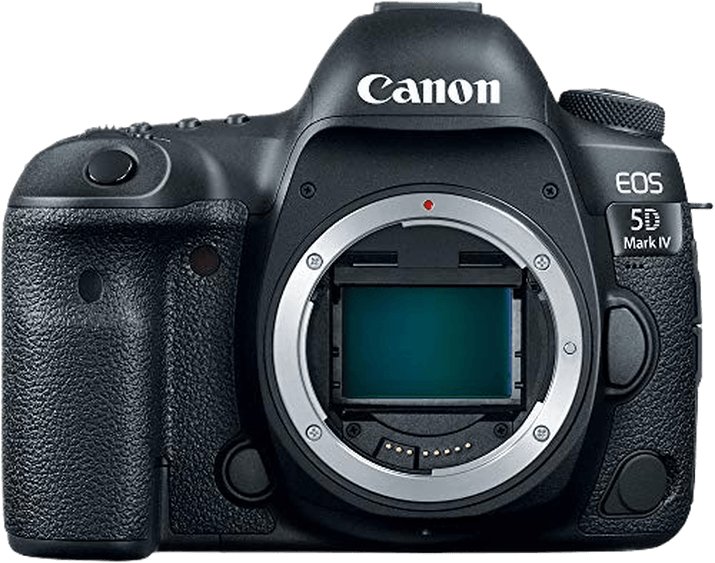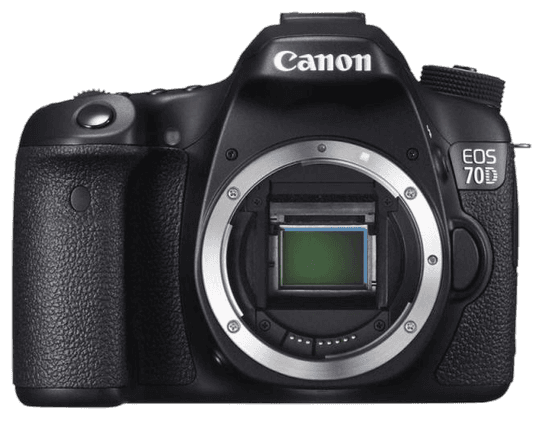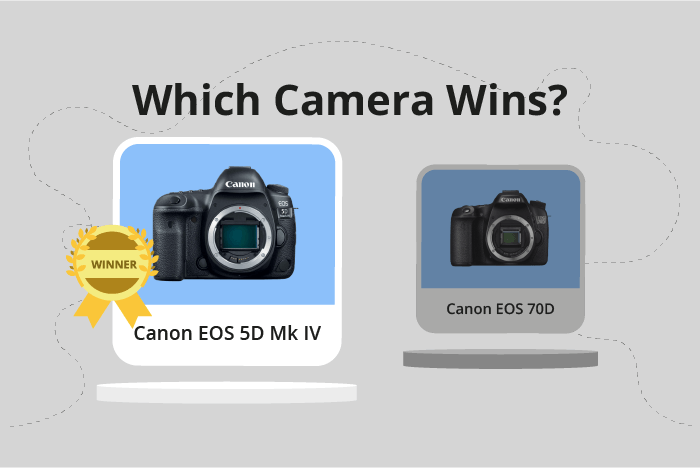Canon EOS 5D Mark IV vs EOS 70D Comparison
Canon EOS 5D Mark IV

Canon EOS 70D

The Canon EOS 5D Mark IV emerges as the winner with a score of 75/100, while the Canon EOS 70D scores 60/100. Both cameras share commonalities as DSLRs, announced in 2016 and 2013, respectively. The 5D Mark IV surpasses the 70D with its larger size (151 x 116 x 76mm) and heavier weight (890g / 1.96lbs), which may indicate a more robust build and better ergonomics. However, the 70D has a smaller size (139 x 104 x 79mm) and lighter weight (755g / 1.66lbs), which could be an advantage for those seeking a more compact and portable camera.
Despite the higher score, the 5D Mark IV’s launch price is significantly steeper at $3500, compared to the 70D’s $1199 price tag. This difference may make the 70D a more budget-friendly option for some photographers. Ultimately, the choice between these two cameras depends on the user’s priorities, preferences, and budget.
Canon EOS 5D Mark IV vs EOS 70D Overview and Optics
The Canon EOS 5D Mark IV outperforms the Canon EOS 70D in optics with a score of 76/100 compared to 58/100. Both cameras share common specifications, including a 7 fps shooting speed, a CMOS sensor, and no image stabilization. However, the 5D Mark IV has superior features that contribute to its higher score.
The 5D Mark IV has a 30.4-megapixel sensor, providing higher resolution and more detail in images than the 70D’s 20.2-megapixel sensor. The 5D Mark IV also has a more advanced processor, the Digic 6+, which improves image processing and overall camera performance. Furthermore, its sensor has a higher DXOMARK score of 91, indicating better image quality, compared to the 70D’s score of 68.
The 5D Mark IV’s full-frame sensor size offers a larger field of view and better low-light performance than the 70D’s APS-C sensor. Additionally, the 5D Mark IV uses a Canon EF lens mount, which is compatible with a wider range of lenses than the 70D’s Canon EF-S mount.
However, the 70D has some advantages over the 5D Mark IV, primarily in terms of cost and size. The 70D is a more affordable option for photographers on a budget, and its smaller sensor size makes it more compact and lightweight, which can be beneficial for travel or casual photography.
To conclude, the Canon EOS 5D Mark IV’s superior optics make it a better choice for professional photographers and those seeking the highest quality images. The Canon EOS 70D, while not as advanced, still offers good image quality and may be a more suitable option for those prioritizing cost and portability.
Canon EOS 5D Mark IV vs EOS 70D Video Performance
The Canon EOS 5D Mark IV outperforms the Canon EOS 70D in video capabilities with a significant difference in their scores, 91/100 and 43/100 respectively. Both cameras share some common specifications, but the 5D Mark IV offers superior features that contribute to its higher score.
Both cameras have the ability to record video, but the 5D Mark IV has a maximum video resolution of 4K (4096 x 2160) while the 70D can only record in Full HD (1920 x 1080). This means the 5D Mark IV can capture more detailed and higher quality video content. Additionally, the 5D Mark IV has a higher maximum video frame rate of 120fps compared to the 70D’s 30fps, which allows for smoother footage and better slow-motion effects.
One major advantage of the 5D Mark IV is its built-in time-lapse functionality, which the 70D lacks. This feature enables the 5D Mark IV to capture stunning time-lapse videos without the need for additional equipment or software.
The 70D does not have any specific advantages over the 5D Mark IV in terms of video capabilities. Its lower score reflects its limited features compared to the more advanced 5D Mark IV.
Considering the substantial difference in video scores and the 5D Mark IV’s superior specifications, it is evident that the Canon EOS 5D Mark IV is the better option for videographers and content creators. The 70D may be suitable for casual video recording, but the 5D Mark IV offers a more comprehensive range of features and higher quality output for professional use.
Canon EOS 5D Mark IV vs EOS 70D Features and Benefits
The Canon EOS 5D Mark IV outperforms the Canon EOS 70D in features, scoring 74 out of 100 points, while the 70D scores 70 points. Both cameras share some specifications, such as having a touchscreen, Wi-Fi connectivity, and no Bluetooth.
The 5D Mark IV has a larger screen size of 3.2 inches compared to the 70D’s 3-inch screen. The screen resolution of the 5D Mark IV is also higher at 1,620,000 dots, providing better image quality on the screen than the 70D’s 1,040,000 dots. Furthermore, the 5D Mark IV includes GPS functionality, which the 70D lacks. This feature allows photographers to geotag their images, making it easier to organize and locate photos based on location.
On the other hand, the EOS 70D has a flip screen, which the 5D Mark IV does not have. This feature can be useful for capturing images and videos from different angles, especially for vlogging or self-portraits. However, this advantage does not outweigh the benefits offered by the 5D Mark IV.
Considering these differences, the Canon EOS 5D Mark IV is a better camera in terms of features. Its larger and higher-resolution screen, along with GPS functionality, make it more versatile and user-friendly. While the 70D’s flip screen is a useful feature, it does not make up for the other advantages provided by the 5D Mark IV. Therefore, the Canon EOS 5D Mark IV is the superior choice for photographers seeking a camera with enhanced features.
Canon EOS 5D Mark IV vs EOS 70D Storage and Battery
The Canon EOS 5D Mark IV outperforms the Canon EOS 70D in storage and battery with a score of 71/100, compared to the 70D’s 37/100. Both cameras share some specifications, such as accepting SD, SDHC, and SDXC memory cards, and not having USB charging capabilities.
The 5D Mark IV has the advantage of two memory card slots, allowing for more storage and backup options. It accepts both SD (UHS-I compatible) and Compact Flash cards, making it more versatile. The 70D, on the other hand, has only one memory card slot and does not support UHS-I or Compact Flash cards.
In terms of battery life, the 70D slightly edges out the 5D Mark IV with 920 shots per charge, compared to the 5D Mark IV’s 900 shots. However, the 5D Mark IV uses the newer LP-E6N battery type, while the 70D uses the older LP-E6 battery.
Taking these factors into account, the Canon EOS 5D Mark IV is the superior choice in terms of storage and battery, particularly due to its dual memory card slots and greater compatibility with memory card types. The Canon EOS 70D has a marginally better battery life but falls short in other aspects.
Canon EOS 5D Mark IV vs EOS 70D – Our Verdict
Are you still undecided about which camera is right for you? Have a look at these popular comparisons that feature the Canon EOS 5D Mark IV or the Canon EOS 70D:

